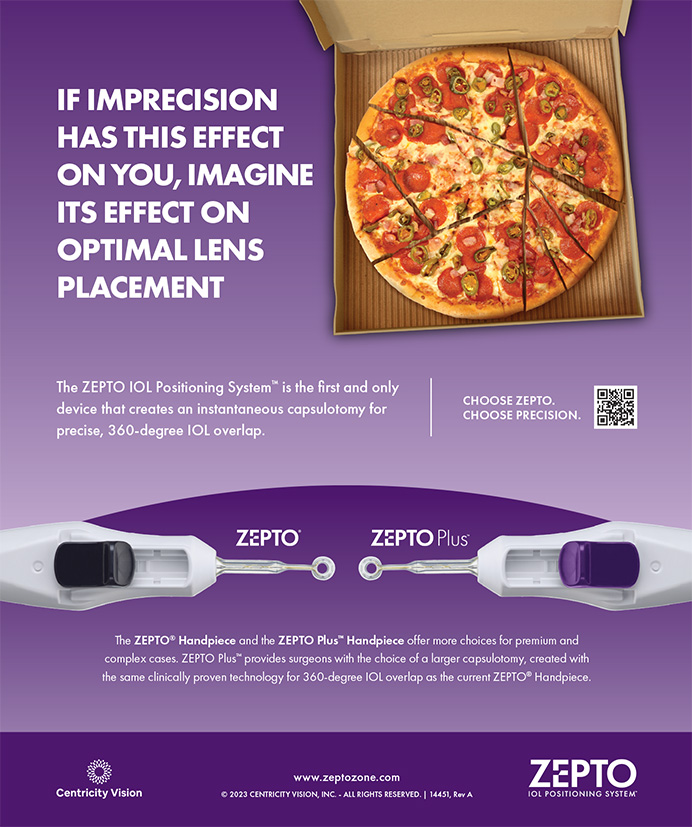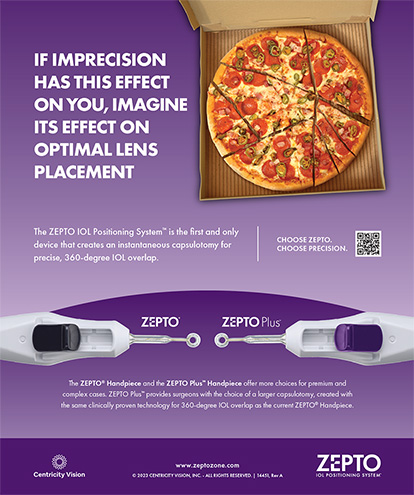CASE PRESENTATION
A 29-year-old male presents to your office for a refractive surgery evaluation. He is strongly motivated to improve his vision in order to achieve freedom from glasses and contact lenses. Currently, he wears a soft, extended-wear contact lens in each eye, and he often leaves the lenses in for 30 days at a time, followed by one night out of contacts; then, the cycle repeats.
The patient has no significant past ocular, medical, or family history. He takes no medications and has no known allergies to medication.
On examination, the patient's uncorrected distance visual acuity is counts fingers at 2 feet in both eyes. His uncorrected near visual acuity at 8 inches is J1 OD and J12 OS. His refraction (both manifest and cycloplegic) is -4.75 D OD and -8.25 D OS, which gives him a visual acuity of 20/15 OD and 20/800 OS. He has normal pupils (scotopic size of 6 mm) and motility. Corneal pachymetry measures 595 µm OD and 598 µm OS. The slit-lamp examination shows clear corneas and anterior segments. The crystalline lenses are clear, and the IOP and dilated fundus examination are normal.
Corneal topography and testing with the Orbscan IIz (Bausch & Lomb, Rochester, NY) show no asymmetry or posterior elevation.
How would you counsel this patient? Would you advocate refractive surgery in a functionally one-eyed individual?
MITCHELL GOSSMAN, MD
This patient may view the elective surgical risk as acceptable despite his relative monocularity. Moreover, it might be argued that the risks of extended-wear contacts exceed those of LASIK. One might recommend he use protective eyewear; to embrace this recommendation yet promote LASIK surgery with the goal of freedom from glasses, however, is somewhat contradictory, and the creation of a flap would make meaningful ocular trauma more likely. Nevertheless, medically speaking, I would be comfortable performing LASIK surgery on this patient if he accepted the risks.
In my opinion, legally, it is a different matter. I am aware of patients who have undergone LASIK without malpractice or even complications and have successfully sued their surgeon based upon subjective complaints alone. Moreover, one needs to consider those cases in which a patient files a lawsuit against the surgeon based on an unfortunate outcome and does not prevail in court, because the court properly finds that no malpractice was committed. Although the surgeon succeeded in court, the entire experience of the lawsuit from start to finish (which may, in some cases, take years) can be psychological and emotional torture for the surgeon. It is also possible that a sympathetic jury may more easily, and wrongly, find for the plaintiff in a case of lost vision in a relatively monocular patient. The resulting adverse verdict for the surgeon could affect his career.
I feel that, until tort laws are reformed to provide more protection against frivolous medical malpractice lawsuits, I would not take this case. Let's change the law and allow patients and physicians the freedom to choose.
SAMUEL MASKET, MD
I prefer a conservative approach to the essentially one-eyed individual. I am quite concerned that this patient uses an extended-wear contact lens in his "good" eye, because the literature suggests at least a five- to 10-fold increase in infectious keratitis with overnight contact lens wear.1 Although I do not fit contact lenses, I have a strong preference for daily disposable products, because they reduce the risks of infection and chemical keratoconjunctivits associated with the storage of contact lenses. Carrying the credo further, I often insist that one-eyed patients use impact-resistant spectacles under many conditions as a protective device.
Regarding corneal or other forms of refractive surgery, I again take a conservative view, although, admittedly, this is more a matter of philosophy than hard facts from the evidence-based literature. The -4.75 D optical error for the patient's right eye is generally well tolerated in spectacles and contact lenses. Although the odds greatly favor a successful outcome with corneal refractive surgery, the risk/benefit ratio, as I see it, is not favorable for surgery.
STEVEN G. SAFRAN, MD
The patient described would theoretically be an excellent candidate for laser vision correction if he had good sight in both eyes. He is the right age, has normal topography and sufficient corneal thickness, and is motivated. There is nothing on examination to give a "cause to pause." The fact that he has only one eye with excellent visual function is the kicker and raises the question of the degree to which a surgeon is willing to risk an essentially monocular patient's "good" eye.
To answer this question, one has to consider relative risk. This patient is currently wearing soft, 30-day extended-wear contact lenses, a practice itself not without risk. A study in 2005 that looked at 4,999 patients over a 12-month period found a rate of 18/10,000 of infectious keratitis with a loss of visual acuity in 3.6/10,000 patients per year.2 In contrast, a study conducted in 2006 that looked at PRK in Army and Navy refractive surgery centers found a rate of infection of 5/25,337, with only one patient losing vision to 20/30 of that group.3 This is a significantly lower rate than that associated with 30-day contact lens wear and represents a one-time risk rather than the annual risk that contact lens wear over time presents. Furthermore, a patient who has recently undergone PRK is under a physician's close supervision during the healing process, whereas a patient who wears contact lenses will not be as closely monitored. Any infection that arises after PRK will likely be treated early and aggressively. A contact lens-related infection can occur at any time, may involve atypical organisms that are difficult to diagnose and treat such as Acanthameoba, and would likely not be detected and treated as promptly as an infection occurring after PRK.
I would advise this patient that he is an excellent candidate for laser vision correction except for the fact that he is risking his "good" eye. I would offer him PRK, which I consider the safest procedure for laser vision correction I can offer, and I would explain to him the relative risk of this surgery versus his current practice of contact lens wear. I would also explain to him that, whether he wears contact lenses or has PRK, he should use protective eye wear when appropriate. I would emphasize that independence from glasses for visual function would not relieve him of the responsibility to protect his eyes. I would tell him that the safest practice is for him to wear shatter-proof (eg, polycarbonate) glasses full time. I would clearly outline the possible complications of PRK (eg, infection, haze, dry eye, undercorrection, overcorrection, ectasia). I would have a synopsis of this discussion and the discussion regarding my recommendations for protective eyewear after PRK documented in the chart, handwritten by myself and signed by the patient and me. If I felt that the patient clearly understood the nature of the procedure, the potential risk, and my recommendations for situational protective eyewear, I would be willing to move forward with surgery, because I believe that his risk from PRK may be the same or less than what he currently faces wearing soft contact lenses over time.
Section editor Karl G. Stonecipher, MD, is the director of refractive surgery at TLC in Greensboro, North Carolina. Parag A. Majmudar, MD, is an associate professor, Cornea Service, Rush University Medical Center, Chicago Cornea Consultants, Ltd. Stephen Coleman, MD, is the director of Coleman Vision in Albuquerque, New Mexico. They may be reached at (847) 882-5900; pamajmudar@chicagocornea.com.
Mitchell Gossman, MD, is in private practice with Eye Surgeons & Physicians in St. Cloud, Minnesota. Dr. Gossman may be reached at mgossman@esppa.com.
Samuel Masket, MD, is a clinical professor of ophthalmology at the University of California, Los Angeles. Dr. Masket may be reached at (310) 229-1220; avcmasket@aol.com.
Steven G. Safran, MD, is in solo private practice in Lawrenceville, New Jersey. Dr. Safran may be reached at (609) 896-3931; safran12@comcast.net.
- Cheng KH, Leung SL Hoekman HW, et al. Incidence of contact-lens-associated microbial keratitis and its related morbidity. Lancet. 1999;354(9174):181-185.
- Schein OD, McNally JJ, Katz J, et al. The incidence of microbial keratitis among wearers of a 30-day silicone hydrogel extended-wear contact lens. Ophthalmology. 2005;112:2172-2179.
- Wroblewski KJ, Pasternak JF, Bower KS, et al. Infectious keratitis after photorefractive keratectomy in the United States army and navy [published online ahead of print February 17, 2006]. Ophthalmology. 2006;113(4):520-525. PMID:16488012.l


